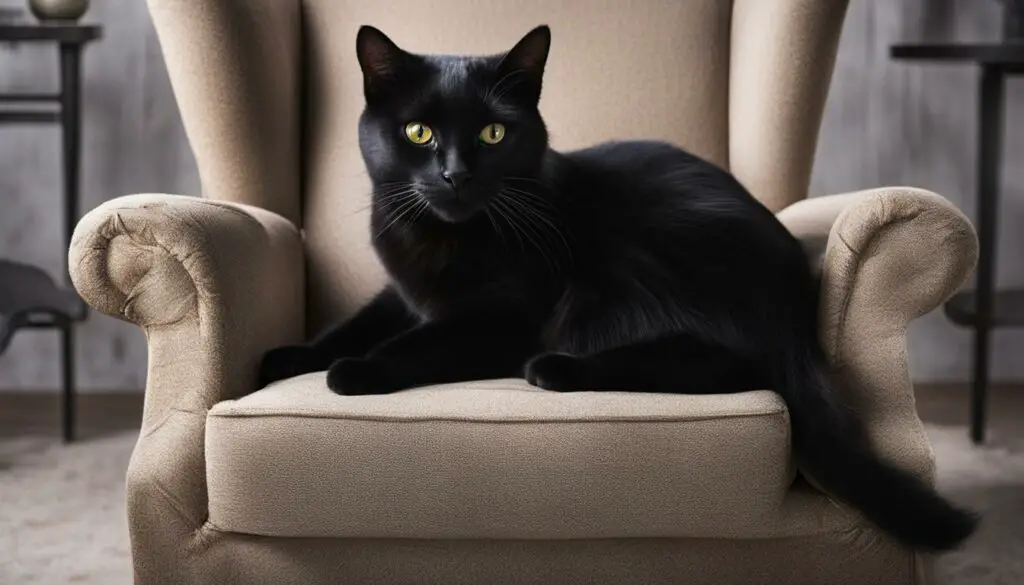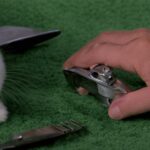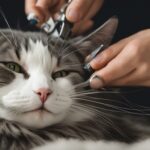Having a cat can be a wonderful experience, but dealing with their clawing behavior can sometimes be a challenge. As a cat owner, you may have found yourself on the receiving end of your cat’s sharp claws, leaving you wondering why they do it. In this article, I will explore the reasons behind this curious behavior and provide you with some valuable insights on how to address it.
Key Takeaways:
- Understanding the reasons behind your cat’s clawing behavior can help you prevent it in the future.
- Cats may dig their claws into you for instinctual reasons, communication, marking territory, aggression, play, or attention-seeking.
- Providing appropriate scratching surfaces, training, and positive reinforcement can help redirect your cat’s clawing behavior.
- Regular nail clipping and promoting positive habits can assist in managing and modifying this behavior.
- Handle clawing behavior with patience, understanding, and gentle methods.
Reasons Why Cats Dig Their Claws Into You
One of the main reasons why cats dig their claws into you is kneading, which is a natural behavior that cats display. Kneading is often associated with feelings of comfort and contentment. It is similar to the motion kittens make when nursing, as they push and pull their paws against a soft surface. When cats knead on your lap or legs, they may dig their claws into you as part of this rhythmic motion.
Cats may also dig their claws into you to sharpen them. Scratching helps cats maintain sharp claws, which is important for various activities like climbing and hunting. By digging their claws into you, cats can remove the outer husk of their claws, revealing the sharp tips underneath. This behavior is instinctive and helps cats keep their claws in optimal condition.
Another reason why cats may dig their claws into you is to pass their scent onto you. Cats have scent glands in between their claws, and scratching you allows them to mark you with their scent. This is a way for cats to communicate and establish their territory. By leaving their scent on you, cats are letting other animals know that you are part of their territory.
Additionally, cats may dig their claws into you as a sign of love and affection. When being petted or receiving a massage, some cats may knead and dig their claws into your skin. This behavior is often accompanied by purring and can be seen as a sign of their affection towards you.
| Reasons Why Cats Dig Their Claws Into You | Description |
|---|---|
| Kneading | Natural behavior associated with comfort and contentment |
| Sharpening | Helps maintain sharp claws for various activities |
| Passing scent | Communicates ownership and territory |
| Love and affection | Expresses fondness and attachment |
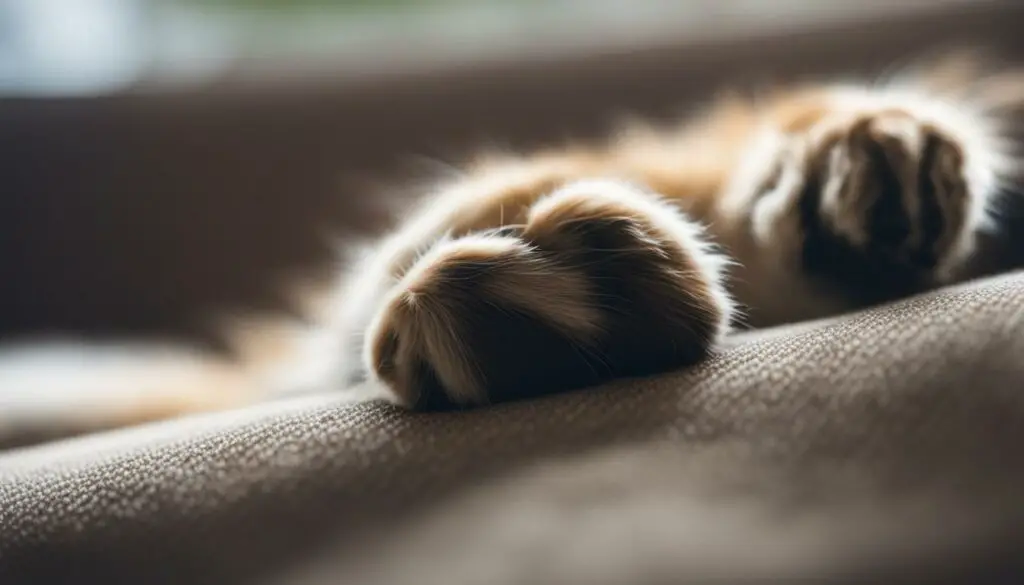
Related Articles:
“Cats have their own unique ways of expressing themselves, and digging their claws into you is one of them. It’s important to remember that this behavior is usually not intended to cause harm, but rather a natural instinct or a way of showing love. By understanding the reasons behind it, you can better address and manage this behavior.”
How to Prevent Your Cat from Digging Their Claws Into You
Cats digging their claws into you can be a frustrating and sometimes painful experience. However, there are preventive measures you can take to redirect this behavior and save your skin. One effective method is providing a scratching board or post for your cat to fulfill their scratching needs. By offering them an alternative surface, you can redirect their instinctual behavior away from clawing you.
Training your cat to use the scratching board or post is also essential. You can encourage them to use it by placing treats or catnip nearby and rewarding them when they scratch the designated surface. Consistency and positive reinforcement are key in shaping their behavior and shifting their focus away from using you as a scratching post.
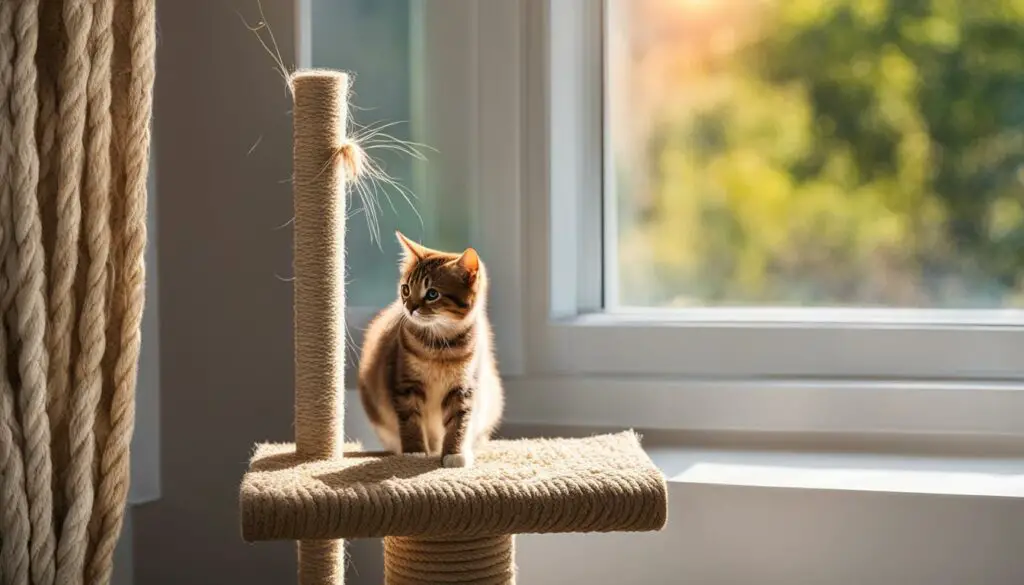
Another preventive measure is to create a scratching-friendly environment by strategically placing multiple scratching posts or boards throughout your home. This ensures that your cat always has an easily accessible and convenient scratching option, reducing the likelihood of them resorting to your furniture or your legs.
Additional Reasons Cats Dig Their Claws Into You
Aside from the reasons mentioned earlier, there are some additional explanations for why cats may dig their claws into you. These behaviors are rooted in their instincts and can provide valuable insights into their emotional state and the dynamics of your bond.
The Release of Stress and Tension
Cats may use the act of digging their claws into you as a way to release stress or tension. This behavior, commonly known as kneading, involves rhythmically pushing their paws against a surface. The repetitive motion can provide them with comfort and relaxation, similar to how a person might squeeze a stress ball. So, if your cat starts kneading and digging their claws into you, it may be a sign that they are seeking relief from stress.
Marking Their Territory
Another reason why cats dig their claws into you is to mark their territory. Cats have scent glands between their paw pads, and when they scratch you, they are leaving their scent behind as a way of claiming ownership. This territorial behavior is a natural instinct and allows them to establish their presence in their environment. So, while it may be a little uncomfortable for you, it’s an indication that your cat feels secure and is asserting their place in your life.
Bonding and Affection
When your cat digs their claws into you, it can also be a display of bonding and affection. This behavior is commonly seen when they are being petted or seeking your attention. By kneading and digging their claws into you, they are expressing their love and forming a close attachment. It’s a way for them to show that they feel safe and comfortable in your presence, and that they trust you completely.
In conclusion, there are various reasons why cats dig their claws into you. It can be a stress release mechanism, a way to mark their territory, or an expression of love and affection. Understanding these additional reasons can help you strengthen your bond with your feline friend and respond effectively to their needs.
Do Cats Know When Their Claws Hurt You?
Cats may not be fully aware of the unintentional pain they can cause when they dig their claws into you. The sensitivity of human skin compared to fur-covered skin is something that most cats do not understand. While they may realize their actions have caused you discomfort if you react strongly to the pain, in many cases, they may not even notice or comprehend the pain they have inflicted.
It is important to remember that cats use their claws for various reasons, such as kneading, marking territory, or for love and affection. Their instinctual behaviors drive them to display these actions without realizing the potential harm they may cause. It is our responsibility as cat owners to guide and redirect their behavior in a gentle and understanding manner.
“Cats may not be fully aware of the unintentional pain they can cause when they dig their claws into you.”
When interacting with your cat, it is crucial to be patient and provide them with appropriate alternatives for clawing. Introducing a scratching post or board can help redirect their behavior away from scratching you. Positive reinforcement during training sessions can also be effective in encouraging them to use these designated surfaces. By doing so, you can gradually reduce the likelihood of unintentional scratching and create an environment where both you and your cat feel safe and comfortable.
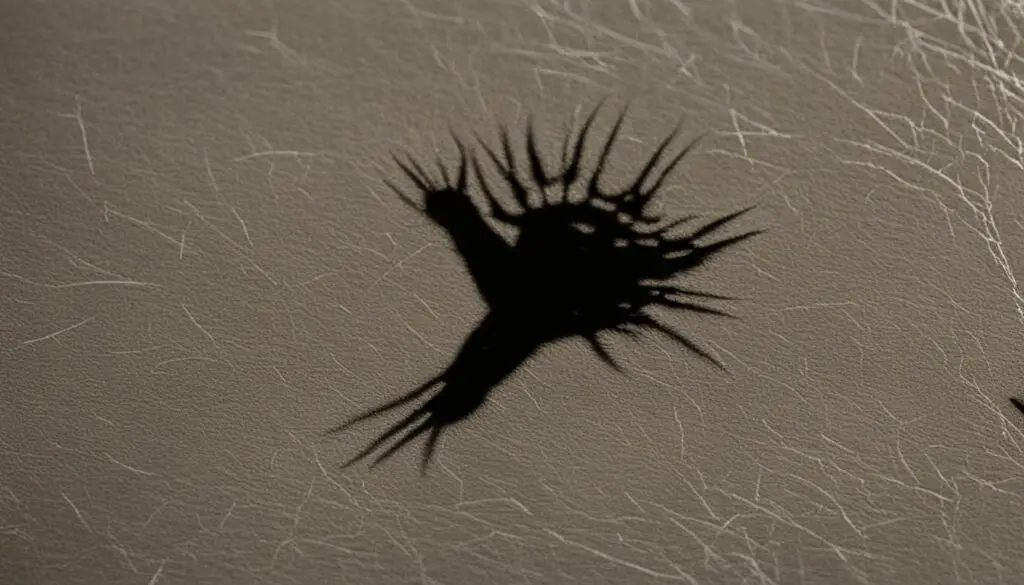
Coping Strategies for Dealing with Cat Clawing Behavior
If your cat keeps clawing you, there are several strategies you can try to address this behavior. One approach is to regularly clip your cat’s nails to keep them shorter and less sharp. Nail clipping can be done at home, but if you are uncertain or uncomfortable with the process, it is best to seek guidance from a professional groomer.
Another strategy is to refuse to pick up your cat when they show signs of clawing. By not reinforcing the behavior with attention, they may eventually learn that clawing is not an effective way to get your attention.
Training your cat to refrain from using their claws during play or interactions is also an effective method. Positive reinforcement techniques, such as rewarding your cat with treats or praise when they use appropriate scratching surfaces, can help modify their behavior over time.
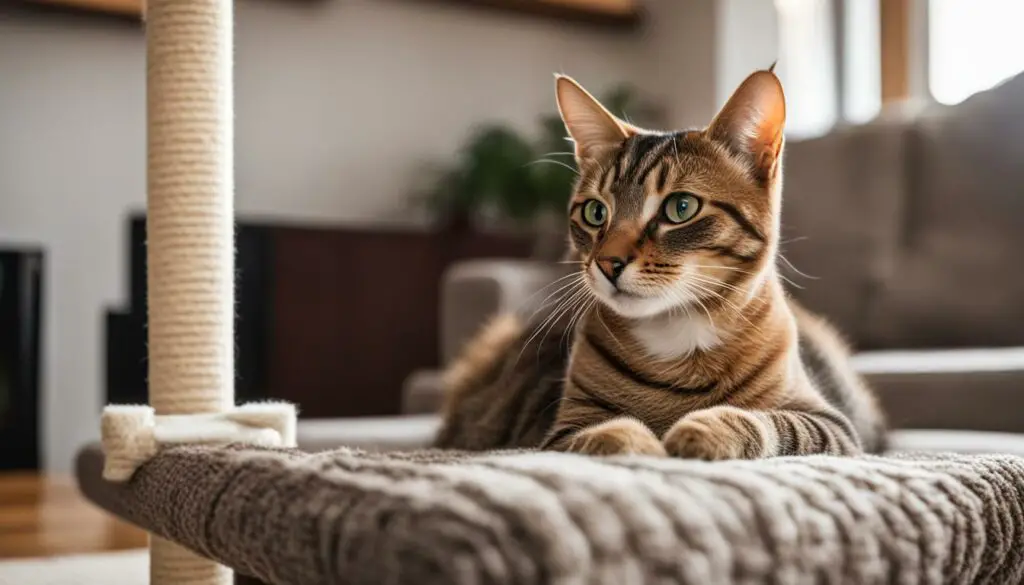
| Strategies to cope with cat clawing behavior | Effectiveness |
|---|---|
| Regular nail clipping | High |
| Refusing to pick up the cat | Moderate |
| Training and positive reinforcement | High |
It is important to remember that changing a cat’s behavior takes time and patience. Consistency is key when implementing these coping strategies. With the right approach and positive reinforcement, you can help your cat develop healthier scratching habits and reduce the instances of clawing behavior.
Teaching Your Cat to Retract Their Claws
If you want to prevent your cat from digging their claws into you, it’s important to teach them to retract their claws properly. This can be achieved through gentle redirection and positive reinforcement. One effective method is to provide alternate scratching surfaces, such as scratching posts or boards, where your cat can fulfill their scratching needs. Reward your cat with treats or praise every time they use these surfaces instead of clawing you. This positive reward system helps them associate the scratching post with a pleasant experience.
Another technique is gentle redirection. If you notice your cat showing signs of clawing you, calmly and gently move them away from you or distract them with a toy or treat. This teaches your cat that clawing is not an appropriate behavior towards you. Additionally, placing a soft blanket between you and your cat can act as a barrier and prevent direct clawing while still allowing for interaction.
Remember, always use gentle and positive methods when teaching your cat to retract their claws. Never punish or yell at your cat, as this can cause confusion and may even lead to retaliation. Patience, consistency, and rewarding good behavior are key to successfully modifying your cat’s clawing habits.
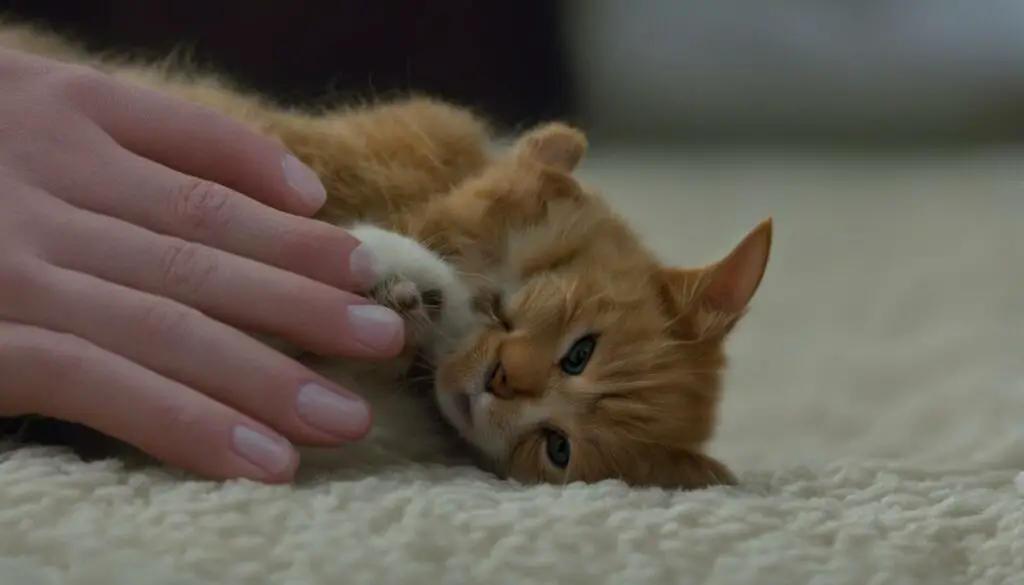
Summary:
- Provide alternate scratching surfaces like scratching posts or boards
- Reward your cat for using these surfaces instead of clawing you
- Use gentle redirection if your cat shows signs of clawing you
- Place a soft blanket between you and your cat as a barrier
- Always use positive and gentle methods, avoiding punishment
Remember, teaching your cat to retract their claws requires patience and consistency. Stay calm, be positive, and reward good behavior. With time and practice, your cat will learn to use appropriate scratching surfaces and minimize clawing you.
Is Clawing on Your Lap Normal?
When your cat digs their claws into your lap, it is actually quite normal behavior. Cats find sitting on your lap a comfortable and secure spot, and kneading their paws can be a way for them to show affection and bond with you. However, if the clawing causes you pain or discomfort, it is important to address it and find ways to prevent it from happening.
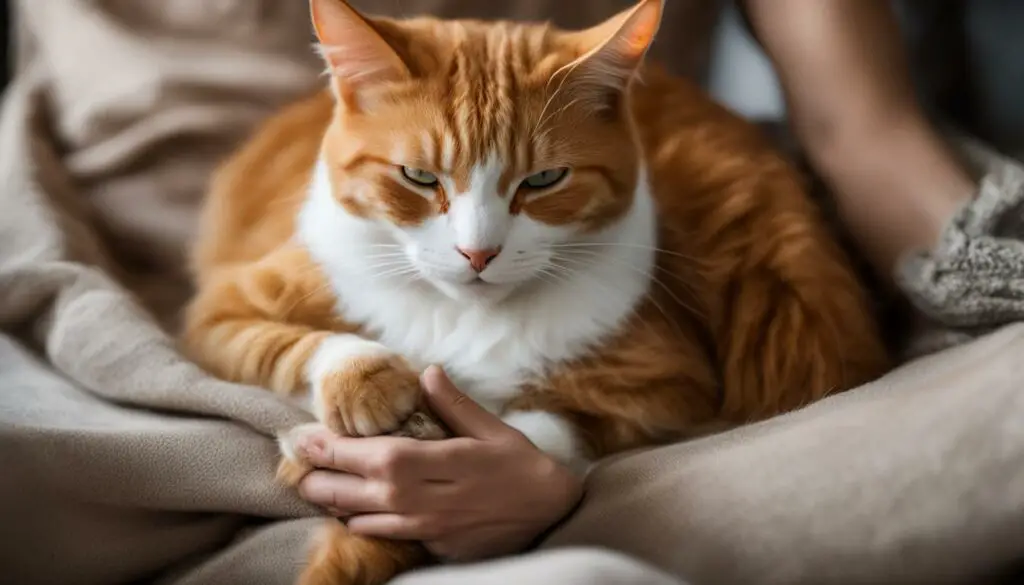
One way to prevent your cat from clawing your lap is by regularly clipping their nails. Keeping your cat’s nails trimmed can make them less sharp and reduce the chance of them accidentally hurting you. Another effective method is providing alternative scratching surfaces, such as scratching posts or boards, where your cat can fulfill their scratching needs. By redirecting their behavior to appropriate surfaces, you can discourage them from clawing your lap.
To summarize, while it is common for cats to dig their claws into your lap as a sign of comfort and bonding, it is important to ensure that it does not cause you pain. Regular nail clipping and providing appropriate scratching surfaces can help prevent clawing on your lap and maintain a harmonious bond with your feline friend.
Table: Preventive Measures for Clawing Behavior
| Preventive Measures | Description |
|---|---|
| Regular Nail Clipping | Trim your cat’s nails regularly to prevent them from becoming too sharp. |
| Provide Alternative Scratching Surfaces | Offer scratching posts or boards as an outlet for your cat’s scratching needs. |
| Redirect Behavior | Gently redirect your cat’s clawing behavior to appropriate surfaces. |
Safety Measures When Trimming Your Cat’s Nails
When it comes to trimming your cat’s nails, it is essential to prioritize safety to prevent any potential injuries. If you feel unsure or uncomfortable performing this task yourself, seeking guidance from a professional groomer is highly recommended. They have the expertise and experience to ensure the process is done correctly and safely.
Professional groomers can provide you with proper techniques for trimming your cat’s nails, ensuring minimal stress and risk to your furry friend. They can also offer valuable advice on how to handle any potential challenges that may arise during the nail clipping process. By entrusting this task to a professional, you can have peace of mind knowing that the well-being of your cat is being taken care of.
“Seeking guidance from a professional groomer can ensure that your cat’s nails are properly trimmed without causing any harm or discomfort.”
Tips for Nail Clipping at Home
If you prefer to trim your cat’s nails at home, there are a few safety measures you can follow to minimize the risk of injury:
- Make sure you have proper nail clippers designed specifically for cats.
- Choose a calm and quiet environment where your cat feels comfortable.
- Start by getting your cat accustomed to having their paws touched and gently manipulated.
- Take breaks during the process if your cat becomes stressed or anxious.
- Be careful not to trim the nails too short, as this can cause pain and bleeding.
Remember, your cat’s safety should always be the top priority, so it’s important to approach nail clipping with patience, caution, and a gentle touch.
| Safety Measures for Nail Clipping |
|---|
| Seek guidance from a professional groomer |
| Use proper cat nail clippers |
| Create a calm and quiet environment |
| Gradually get your cat used to paw handling |
| Take breaks if your cat becomes stressed |
| Avoid trimming nails too short |
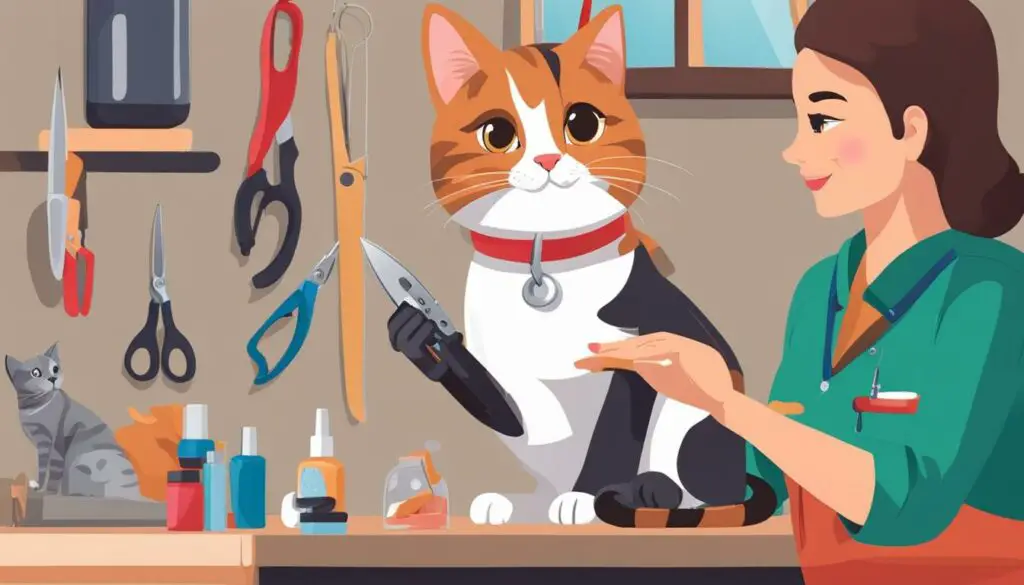
Differentiating Kneading from Clawing
When it comes to your cat’s behavior, it’s essential to differentiate between kneading and clawing. While both actions involve the use of their claws, the intention and harm caused may vary. Kneading is a natural behavior in cats, characterized by the rhythmic pushing in and out motion of their paws against a surface, such as your lap or a blanket. It is a sign of comfort and relaxation, often associated with feelings of trust and affection towards their human.
On the other hand, clawing refers to the act of a cat digging their claws into you with or without intention. While kneading may be a gentle and harmless action, clawing can cause unintentional harm and discomfort. It is important to manage your cat’s claw length through regular nail clipping to prevent them from inadvertently scratching you. By keeping their nails trimmed, you can minimize the chance of accidental scratches and ensure a safe and enjoyable interaction with your furry friend.
Table:
| Kneading | Clawing |
|---|---|
| Gentle and rhythmic paw motion | Forcefully digging claws into surfaces |
| Sign of comfort and trust | Potential for unintentional harm |
| Usually harmless | May cause discomfort or scratches |
By understanding the difference between kneading and clawing, you can better interpret your cat’s behavior and respond appropriately. Encouraging positive habits, such as providing appropriate scratching surfaces and regular nail clipping, can help foster a stronger bond between you and your feline companion without the risk of unintended harm.
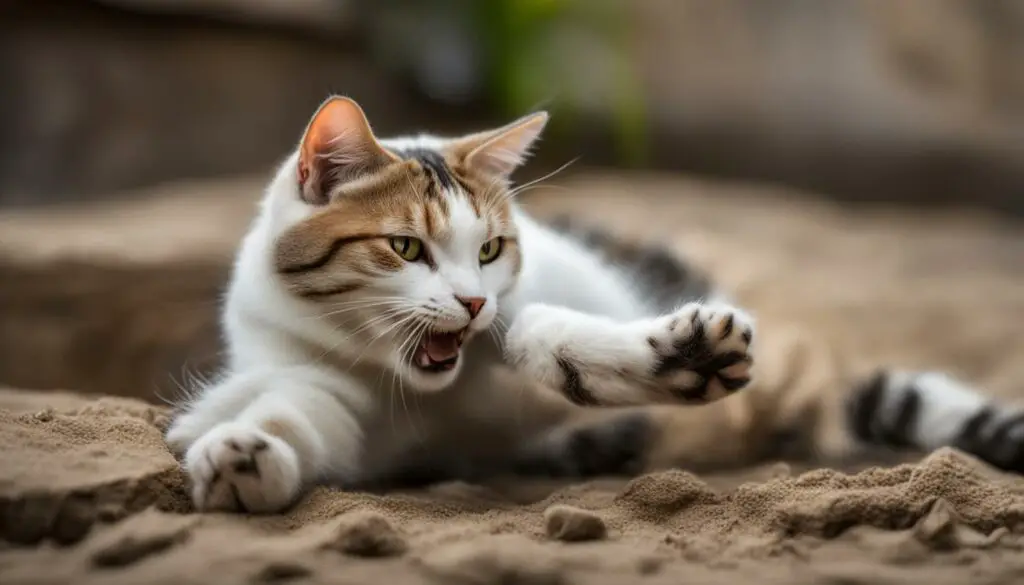
Common Signs of Kneading and Clawing
- Kneading: Rhythmic paw movements, relaxed body posture, purring
- Clawing: Forceful digging of claws, tense body posture, potential discomfort or scratches
Clipping Your Cat’s Nails Correctly
Clipping your cat’s nails may seem intimidating at first, but with practice and guidance, it can become a routine task. Building confidence is key, as cats can sense your hesitation or nervousness. Here are some tips to help you clip your cat’s nails correctly:
1. Gather the necessary tools
To clip your cat’s nails, you’ll need a pair of cat nail clippers or human nail clippers with a straight edge, styptic powder (in case of accidental bleeding), and treats as a reward. Make sure these items are within reach before you begin to minimize any disruptions during the process.
2. Choose a calm and quiet environment
Find a quiet space where you and your cat can relax during the nail clipping session. Minimize distractions and choose a location where your cat feels comfortable, such as a favorite room or a quiet corner. This will help reduce any anxiety or stress for both you and your cat.
3. Start with short clipping sessions
Start by gently handling your cat’s paws and getting them used to touch. Gradually introduce the clippers by touching the nails and rewarding your cat with treats and praise. Begin with short clipping sessions, focusing on one or two nails at a time. Take breaks if needed to give your cat a chance to relax.
Remember, if you’re unsure or uncomfortable with clipping your cat’s nails, seeking guidance from a professional groomer is always an option. They can provide you with step-by-step instructions and demonstrate the proper technique to ensure the safety and well-being of your cat.
| Benefits of clipping your cat’s nails | Tips for successful nail clipping |
|---|---|
| 1. Prevents painful ingrown nails | 1. Practice patience and remain calm |
| 2. Reduces the risk of accidental scratching injuries | 2. Use gentle and steady pressure when clipping |
| 3. Protects against damage to furniture and surfaces | 3. Reward your cat with treats and praise |
| 4. Promotes comfortable interactions with you and others | 4. Take breaks if your cat becomes anxious or stressed |
Clipping your cat’s nails can be a positive and bonding experience when done correctly. With patience, repetition, and proper technique, you can successfully maintain your cat’s nail health and reduce the risk of scratching incidents.
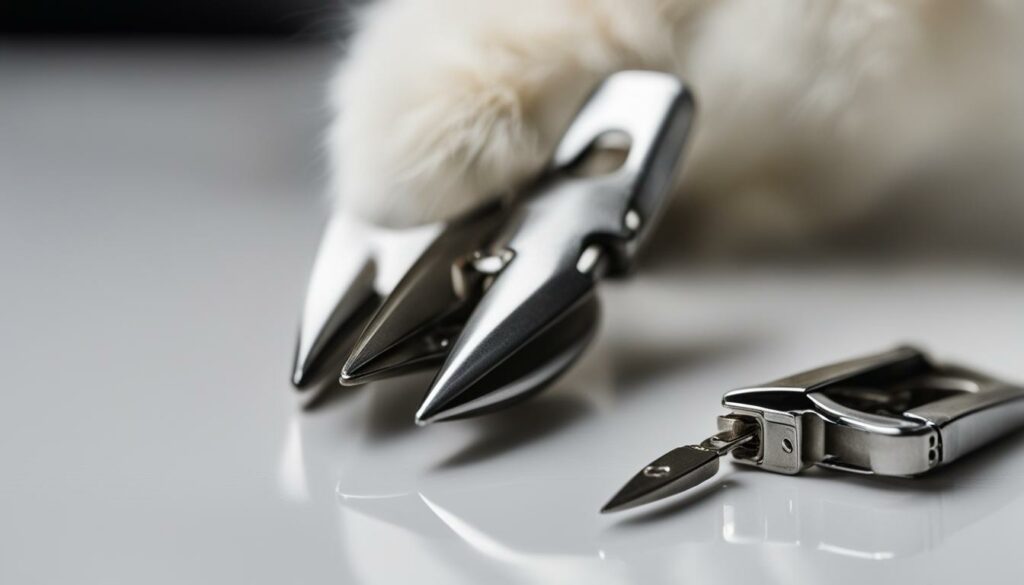
Discipline and Clawing Behavior
When it comes to addressing your cat’s clawing behavior, it’s important to approach discipline with caution. Using negative reinforcement, such as punishment, can lead to confusion and even retaliation from your cat. Cats are not able to connect the punishment with their clawing behavior, which can leave them feeling confused and stressed. Instead of focusing on discipline, it’s more effective to redirect their behavior and provide appropriate scratching surfaces.
Negative reinforcement can create a negative association between you and your cat, damaging the bond and trust between you. It’s essential to remember that clawing is a natural behavior for cats, and they may not understand that it is causing you discomfort. Punishing them for this behavior can lead to fear and stress, which can result in further behavioral issues.
Instead of discipline, focus on providing alternative scratching surfaces for your cat. A scratching post or board can redirect their instinctual need to scratch while protecting your furniture and your skin. Encourage your cat to use these surfaces by placing treats or toys near the scratching post and rewarding them when they use it. Positive reinforcement and redirection are key in effectively managing and modifying your cat’s clawing behavior.
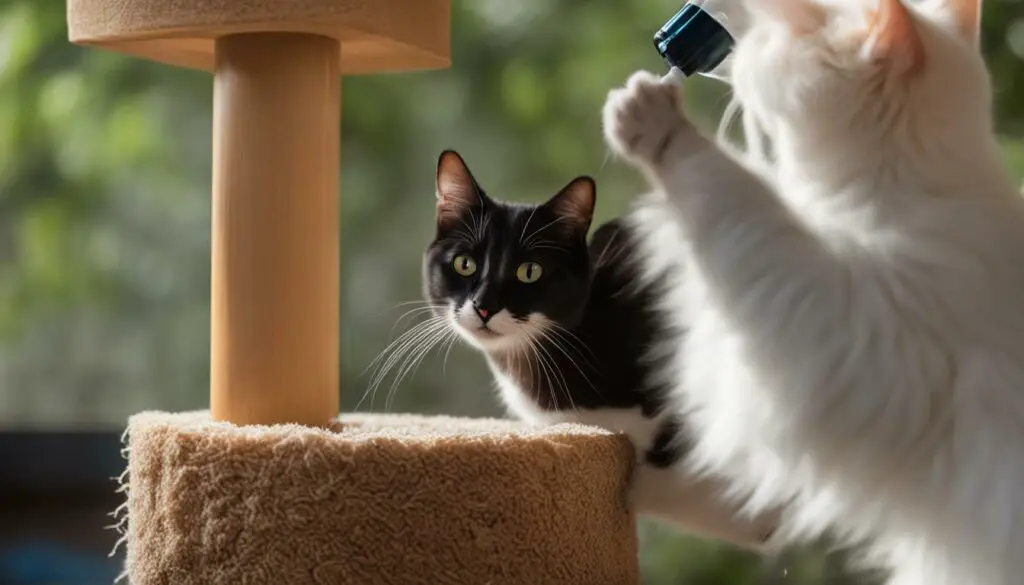
Tips for Redirecting Your Cat’s Clawing Behavior:
- Provide a scratching post or board as an alternative to clawing on you or furniture.
- Place treats or toys near the scratching surface to encourage your cat to use it.
- Reward your cat with praise or treats when they use the appropriate scratching surface.
- Be patient and consistent in redirecting their behavior. It may take time for them to adjust.
The Meaning Behind Paw Extension
When a cat extends its paws onto your legs, it is often a sign of trust and affection. This behavior shows that your cat feels comfortable and safe in your presence. Paw extension is a vulnerable gesture that indicates a close bond between you and your cat.
Trust is a critical element in any relationship, including the one you share with your feline companion. When your cat extends their paws onto your legs, it demonstrates that they trust you enough to expose their vulnerable underside. This action is similar to a human reaching out for a hug or cuddle, a gesture of affection and a desire for closeness.
It’s important to recognize and respect your cat’s paw extension as a positive behavior. By reciprocating their trust and providing a safe and comforting environment, you can nurture the bond between you and your beloved feline friend.
Differentiating Fun and Aggressive Clawing
Understanding your cat’s body language is crucial in determining whether their clawing behavior is playful or aggressive. Playful clawing is typically accompanied by relaxed body language, play bows, or purring. It is a way for cats to engage in interactive play and release their pent-up energy. This type of clawing is usually not intended to cause harm and is more likely a result of their natural instincts.
On the other hand, aggressive clawing may involve tense body posture, hissing, or growling. Cats may display aggression when they feel threatened or fearful. It is important to be able to differentiate between the two behaviors to ensure the well-being of both you and your cat.
Body language cues to look out for:
- Playful clawing: Relaxed body posture, wagging tail, ears forward, purring
- Aggressive clawing: Tense body posture, arched back, tail thrashing, ears pinned back, hissing or growling
If your cat’s clawing behavior appears to be aggressive, it is important to seek professional guidance to address the behavior effectively. Aggression in cats can be a sign of underlying issues that require a tailored approach to resolve. A certified behaviorist or veterinarian can provide you with expert advice and techniques to manage and modify the aggression.
Example table:
| Body Language | Playful Clawing | Aggressive Clawing |
|---|---|---|
| Body Posture | Relaxed | Tense |
| Tail | Wagging | Thrashing |
| Ears | Forward | Pinned back |
| Sounds | Purring | Hissing or growling |
Remember, every cat is unique, and their behavior can vary. Monitoring their body language and seeking professional advice when necessary will help you ensure a happy and healthy relationship with your feline companion.
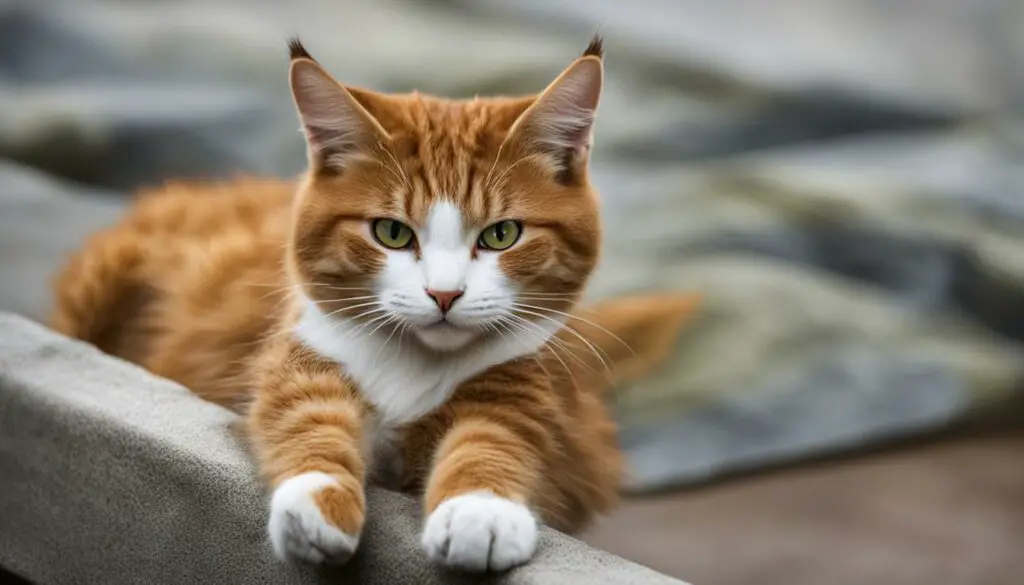
Conclusion: Understanding and Addressing Cat Clawing Behavior
Dealing with cat clawing behavior can be frustrating, but with the right knowledge and strategies, you can effectively address this issue. Cats may dig their claws into you for various reasons, including instinctual behavior, communication, marking territory, or as a sign of love and affection. By understanding these motives, you can take preventive measures to redirect their clawing behavior.
One approach is to provide your cat with appropriate scratching surfaces, such as scratching posts or boards, and train them to use these instead of clawing you. Regular nail clipping can also help keep their claws shorter and less sharp. Positive reinforcement, through rewards and gentle redirection, can encourage your cat to adopt more desirable behaviors.
It’s important to remember that disciplining your cat for clawing is not recommended, as this can cause confusion and may even lead to retaliation. Instead, focus on reinforcing positive habits and providing your cat with outlets to fulfill their scratching needs. With patience, understanding, and gentle methods, you can effectively manage and modify your cat’s clawing behavior.
In conclusion, addressing cat clawing behavior requires a comprehensive approach that takes into account the reasons behind this behavior and implements preventive measures and positive reinforcement techniques. By understanding your cat’s needs and providing suitable alternatives, you can create a harmonious environment where both you and your feline companion can coexist happily.
FAQ
Why does my cat dig his claws into me?
Cats may dig their claws into you for various reasons, including instinctual behavior, communication, marking territory, aggression, play, or attention-seeking.
What are some reasons why cats dig their claws into you?
Some reasons include kneading, sharpening their claws, passing scent, and showing love and affection.
How can I prevent my cat from digging their claws into me?
Providing a scratching board or post, training your cat to use them, and offering an appropriate outlet for scratching can help prevent clawing behavior.
Are there additional reasons why cats dig their claws into people?
Yes, cats may also do it to release stress, mark their territory, or as a bonding behavior.
Do cats know when their claws hurt you?
Cats may not be fully aware of the pain they cause when scratching humans, and their intention is usually not to harm.
How can I cope with cat clawing behavior?
Strategies include regular nail clipping, refusing to pick up your cat, and positive reinforcement training.
How can I teach my cat to retract their claws?
Providing alternate scratching surfaces, rewarding proper use, and gently redirecting behavior can help train your cat to retract their claws.
Is clawing on my lap normal?
Clawing on your lap is a natural behavior, but if it causes discomfort, you can consider nail clipping or providing an alternative scratching surface.
Are there any safety measures for trimming my cat’s nails?
If you’re uncertain or uncomfortable with nail clipping, seek guidance from a professional groomer to ensure your cat’s safety.
How do I differentiate kneading from clawing?
Kneading is a natural behavior, while clawing can be unintentional. Regular nail clipping can help prevent unintentional scratching.
How do I clip my cat’s nails correctly?
Start by observing a professional groomer or veterinarian to learn the proper technique. With practice, you can gain confidence in trimming your cat’s nails.
Should I discipline my cat for clawing behavior?
Negative reinforcement is not recommended. Instead, focus on redirecting behavior, providing appropriate scratching surfaces, and reinforcing positive habits.
What does paw extension mean?
Paw extension is a sign of trust and affection, indicating that your cat feels comfortable and safe in your presence.
How do I differentiate fun and aggressive clawing?
Understanding your cat’s body language is crucial. Playful clawing is accompanied by relaxed behavior, while aggressive clawing involves tension and warning signs.
What should I know about cat clawing behavior?
Understanding the reasons behind it and implementing preventive measures, training, and nail care can help manage and modify this behavior with patience and gentle methods.

